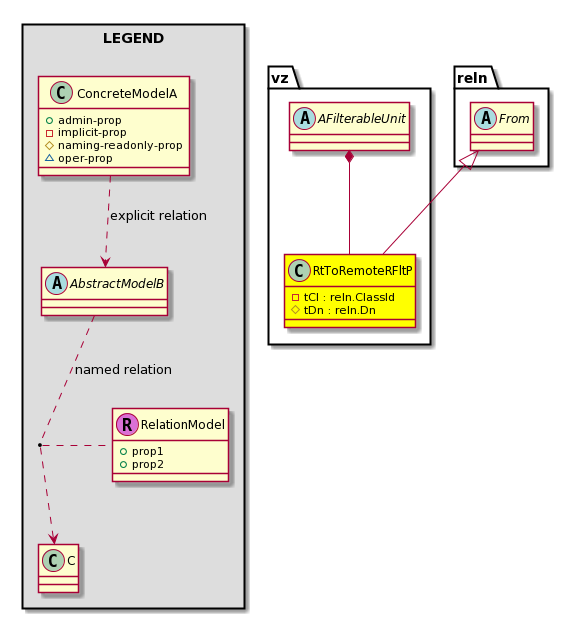![[V]](styles/eye.gif) |
top:Root This class represents the root element in the object hierarchy.
All managed objects in the system are descendants of the Root element. |
|
|
|
|
|
├
|
![[V]](styles/eye.gif) |
pol:Uni Represents policy definition/resolution universe. |
|
|
|
|
|
|
├
|
![[V]](styles/eye.gif) |
fv:Tenant A policy owner in the virtual fabric. A tenant can be either a private or a shared entity. For example, you can create a tenant with contexts and bridge domains shared by other tenants. A shared type of tenant is typically named common, default, or infra. |
|
|
|
|
|
|
|
|
├
|
![[V]](styles/eye.gif) |
vz:RtToRemoteRFltP |
![[V]](styles/eye.gif) |
top:Root This class represents the root element in the object hierarchy.
All managed objects in the system are descendants of the Root element. |
├
|
![[V]](styles/eye.gif) |
pol:Uni Represents policy definition/resolution universe. |
|
├
|
![[V]](styles/eye.gif) |
fv:Tenant A policy owner in the virtual fabric. A tenant can be either a private or a shared entity. For example, you can create a tenant with contexts and bridge domains shared by other tenants. A shared type of tenant is typically named common, default, or infra. |
|
|
|
├
|
![[V]](styles/eye.gif) |
vz:RtToRemoteRFltP |
![[V]](styles/eye.gif) |
top:Root This class represents the root element in the object hierarchy.
All managed objects in the system are descendants of the Root element. |
|
|
|
├
|
![[V]](styles/eye.gif) |
top:System The APIC uses a policy model to combine data into a health score. Health scores can be aggregated for a variety of areas such as for the infrastructure, applications, or services. The category health score is calculated using a Lp -Norm formula. The health score penalty equals 100 minus the health score. The health score penalty represents the overall health score penalties of a set of MOs that belong to a given category and are children or direc... |
|
|
|
|
|
├
|
![[V]](styles/eye.gif) |
actrl:Flt The filter rules identifying a group of filter entries. |
|
|
|
|
|
|
├
|
![[V]](styles/eye.gif) |
vz:RtToRemoteRFltP |
![[V]](styles/eye.gif) |
top:Root This class represents the root element in the object hierarchy.
All managed objects in the system are descendants of the Root element. |
├
|
![[V]](styles/eye.gif) |
top:System The APIC uses a policy model to combine data into a health score. Health scores can be aggregated for a variety of areas such as for the infrastructure, applications, or services. The category health score is calculated using a Lp -Norm formula. The health score penalty equals 100 minus the health score. The health score penalty represents the overall health score penalties of a set of MOs that belong to a given category and are children or direc... |
|
|
├
|
![[V]](styles/eye.gif) |
actrl:Flt The filter rules identifying a group of filter entries. |
|
|
|
├
|
![[V]](styles/eye.gif) |
vz:RtToRemoteRFltP |
![[V]](styles/eye.gif) |
top:Root This class represents the root element in the object hierarchy.
All managed objects in the system are descendants of the Root element. |
|
|
|
|
|
├
|
![[V]](styles/eye.gif) |
pol:Uni Represents policy definition/resolution universe. |
|
|
|
|
|
|
├
|
![[V]](styles/eye.gif) |
fv:Tenant A policy owner in the virtual fabric. A tenant can be either a private or a shared entity. For example, you can create a tenant with contexts and bridge domains shared by other tenants. A shared type of tenant is typically named common, default, or infra. |
|
|
|
|
|
|
|
|
├
|
![[V]](styles/eye.gif) |
vz:RtToRemoteRFltP |
![[V]](styles/eye.gif) |
top:Root This class represents the root element in the object hierarchy.
All managed objects in the system are descendants of the Root element. |
├
|
![[V]](styles/eye.gif) |
pol:Uni Represents policy definition/resolution universe. |
|
├
|
![[V]](styles/eye.gif) |
fv:Tenant A policy owner in the virtual fabric. A tenant can be either a private or a shared entity. For example, you can create a tenant with contexts and bridge domains shared by other tenants. A shared type of tenant is typically named common, default, or infra. |
|
|
|
├
|
![[V]](styles/eye.gif) |
vz:RtToRemoteRFltP |
![[V]](styles/eye.gif) |
top:Root This class represents the root element in the object hierarchy.
All managed objects in the system are descendants of the Root element. |
|
|
|
|
|
├
|
![[V]](styles/eye.gif) |
pol:Uni Represents policy definition/resolution universe. |
|
|
|
|
|
|
├
|
![[V]](styles/eye.gif) |
fv:Tenant A policy owner in the virtual fabric. A tenant can be either a private or a shared entity. For example, you can create a tenant with contexts and bridge domains shared by other tenants. A shared type of tenant is typically named common, default, or infra. |
|
|
|
|
|
|
|
├
|
![[V]](styles/eye.gif) |
vz:Filter A filter policy is a group of resolvable filter entries. Each filter entry is a combination of network traffic classification properties. |
|
|
|
|
|
|
|
|
├
|
![[V]](styles/eye.gif) |
vz:RtToRemoteRFltP |
![[V]](styles/eye.gif) |
top:Root This class represents the root element in the object hierarchy.
All managed objects in the system are descendants of the Root element. |
├
|
![[V]](styles/eye.gif) |
pol:Uni Represents policy definition/resolution universe. |
|
├
|
![[V]](styles/eye.gif) |
fv:Tenant A policy owner in the virtual fabric. A tenant can be either a private or a shared entity. For example, you can create a tenant with contexts and bridge domains shared by other tenants. A shared type of tenant is typically named common, default, or infra. |
|
|
├
|
![[V]](styles/eye.gif) |
vz:Filter A filter policy is a group of resolvable filter entries. Each filter entry is a combination of network traffic classification properties. |
|
|
|
├
|
![[V]](styles/eye.gif) |
vz:RtToRemoteRFltP |
|

